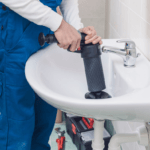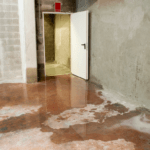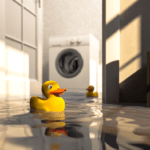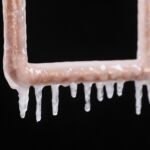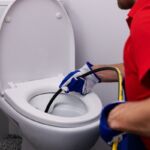A clogged bathroom sink is one of the most frustrating household plumbing issues. You turn on the faucet, expecting water to flow freely, only to be met with a slow drip or no water. Basic tasks like brushing your teeth or washing your face become messy.
In this comprehensive guide, we’ll walk through the causes of clogged drains, preventative steps you can take, and a step-by-step process for clearing your bathroom sink drain using everyday household items.
What Causes Clogged Sink Drains?
Several common culprits can lead to clogged or slow-flowing sink drains:
Hair, Soap Scum, and Debris Buildup
Over time, strands of hair, soap residue, and other gunk passing through the drain can accumulate along the pipes. This sticky mass catches other debris flowing down the drain, eventually blocking water flow.
Toiletries
Thick shampoos, conditioners, and creams can congeal and clog drains. Avoid pouring excessive amounts down the sink.
Food Waste
Leftover bits of food, oils, and grease wash down the drain and coat pipes. Use sink strainers to catch food particles.
Mineral Deposits
Hard water containing high mineral content can leave behind calcium, lime, and rust deposits inside pipes over time.
Foreign Objects
Dropped rings, bobby pins, or other small items can get stuck in pipes. Be careful not to wash objects down the drain.
Tree Roots
Roots from shrubs or trees near external plumbing may grow into and block drain lines.
Prevention Is Key
An ounce of prevention is worth a pound of cure for clogged drains. Here are some simple habits to keep your bathroom sink pipes clear:
- Use drain catchers and screens to trap hair and debris before it enters the drain. Clean them regularly.
- Pour drain cleaners down your sink every month to dissolve buildups. Products with active ingredients like sodium hydroxide or sulfuric acid work best.
- Flush pipes with boiling water monthly to melt fatty deposits. Pour a full kettle down the drain, sit for 5-10 minutes, then flush with cold water.
- Use a zip-it drain cleaning tool regularly to pull out hair caught in pipes before it accumulates.
- Ensure the bathroom sink drains dry entirely after use by removing any standing water with a paper towel.
Unclogging a Bathroom Sink: Step-by-Step
If your bathroom sink is moving slowly or not draining at all, try these methods to clear the clog:
1. Try a Plunger
- The suction force created by a sink plunger can dislodge minor clogs near the drain opening.
- Fill the stopped sink with enough water to cover the drain hole completely.
- Submerge the plunger into the water and position it directly over the drain hole to form a tight seal.
- Plunge up and down vigorously 10-15 times to dislodge the clog through pressure.
- If the plunger starts to pull up the sink stopper, you may need to hold it down lightly with your other hand.
- Drain the sink and run water to check if the clog cleared.
2. Use a Snake/Auger
- A slender drain snake or auger is required for deeper clogs a plunger can’t reach. The metal coil at the end grabs and pulls out the blockage.
- Start by detaching the curved section of piping underneath the sink, known as the P-trap. Place a bucket beneath it to catch water.
- Feed the drain snake into the sink drain until you feel resistance, then crank the handle to work through the clog.
- Once the clog is dislodged, remove any debris from the snake before carefully withdrawing it from the pipes.
- Reattach the cleaned P-trap once draining is restored.
3. Try a Chemical Drain Cleaner
- Liquid drain cleaners use harsh chemicals like lye or sulfuric acid to dissolve gunk, hair, and oils. They come premixed or as two separate solutions before being poured down the drain.
- Wear gloves, goggles, and old clothes for safety when handling chemicals.
- Remove sink drain stoppers before pouring cleaner down the drain.
- Let the cleaner sit for 10-15 minutes before running hot water to flush residue.
- Repeat treatments may be needed for tough clogs.
4. Remove and Clean Pipes Manually
- The nuclear option for stubborn clogs that persist is to detach pipes under the sink and clean them manually. This ensures you can thoroughly inspect and rinse out pipes.
- Place a bucket under the trap, unscrew the slip nuts, and connect it to the drain lines. Set parts aside carefully.
- Check inside pipes and remove any debris by hand or with tongs. Scrub with a bottle brush.
- Thoroughly rinse pipes and reassemble them. Test water flow before replacing cabinets.
When to Call a Professional Plumber
While many bathroom sink clogs can be cleared with essential tools, know when to bring in a pro:
- You’ve tried multiple home remedies without success
- The sink backs up with bubbling water, indicating a deeper main line issue
- You need pipes or plumbing disassembled to access clogs
- Drain issues recur frequently
- Sewage odours persist even after cleaning the drain
Our Licensed Plumbers at Tap Tech have over 25 years of plumbing expertise. Our high-powered hydro jetting tools can scour tough drain clogs that regular augers can’t.
Call 343-305-1172 for same-day emergency service and all your plumbing and drain problems!


